Gustave Eiffel
| Alexandre Gustave Eiffel | |
|---|---|
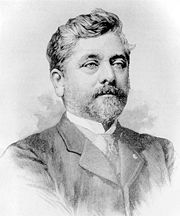 |
|
| Born | December 15, 1832 Dijon, Côte-d'Or, France |
| Died | December 27, 1923 (aged 91) Rue Rabelais in Paris |
| Nationality | French |
| Work | |
| Significant projects | Eiffel Tower and Statue of Liberty |
Alexandre Gustave Eiffel né Bönickhausen (December 15, 1832 – December 27, 1923; French pronunciation: [efɛl], English: /ˈaɪfəl/) was a French structural engineer from the École Centrale Paris, an entrepreneur and a specialist of metallic structures. He is famous for designing the Eiffel Tower, built 1887–1889 for the 1889 Universal Exposition in Paris, France, the armature for the Statue of Liberty, New York Harbor, United States and the San Sebastian Church in Manila, Philippines.

Contents |
Early life
Alexandre Gustave Eiffel was born in Dijon, Côte-d'Or, France. The name Eiffel was adopted by his father in the early 19th century from his birthplace in the German Eifel region (in Marmagen), as the French could not pronounce his actual surname, Bönickhausen. During his youth, the two strongest influences on Eiffel were both successful chemists, his uncles Jean-Baptiste Mollerat and Michel Perret. Both men spent a lot of time with young Eiffel, filling his head with everything from chemistry and mining to religion and philosophy. At school, Eiffel was extremely clever, but not very studious. While attending high school at Lycée Royal, Eiffel was bored and felt that the classes were a waste of time. It was not until his last two years at school that Eiffel found his niche; not in engineering, but in history and literature. Eiffel's study habits improved and he graduated with a degree in both science and humanities. Eiffel went on to attend college at Sainte Barbe College in Paris, in order to prepare for the difficult entrance exams into the most prestigious engineering institutions in France. Ultimately, Eiffel attended the École Centrale des Arts et Manufactures in Paris where he studied chemistry, receiving the equivalent of a Master of Science degree in 1855. École Centrale was a liberal private school that is now known as one of the top engineering schools in Europe. His mother's coal business provided ample income for the family and provided the funds for Gustave to receive his university education. The year 1855 was the same year that Paris hosted the first World's Fair.[1] After graduation, Eiffel's uncle offered him a job at his vinegar works in Dijon, France. However, a family dispute removed that opportunity, and Eiffel soon accepted entry-level employment with a company that designed railway bridges.
Charles Nepveu provided Eiffel with his first job as one of many project managers for a railway bridge located in Bordeaux, France. During the construction process, fellow engineers on the project were steadily quitting, and Eiffel eventually took charge of the entire project. Nepveu saw the work that Eiffel performed on the site, and continued to place Eiffel in other jobs that involved project management of railway bridges and structures. During these projects, Eiffel got to know other engineers of the time, and he would be remembered for his work and allowed to work on other projects. Nepveu was a strong influence on Eiffel that helped him become more successful with his future projects.
Career

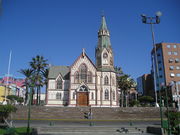
Eiffel et Cie., Eiffel's consulting and construction firm, with the support of Belgian Gustave Eiffel also designed La Ruche in Paris, France. This, like the Eiffel Tower, became a city landmark. It is a three-storey circular structure that looks like a large beehive and was created as a temporary structure for use as a wine rotunda at the Great Exposition of 1900. The French translation of La Ruche is "the beehive". He also constructed the Garabit viaduct, a railway bridge near Ruynes en Margeride in the Cantal département. In the Americas, Eiffel designed the central railway station in Santiago de Chile (1897) and the Mona Island Light located near Puerto Rico. The lighthouse was built around 1900 by the United States which acquired the island after the end of the Spanish-American War. It was decommissioned in 1976.[2]
In 1887, suffered from serious mismanagement, and finally collapsed with enormous losses. Eiffel's reputation suffered a severe setback when he was implicated in the financial scandals surrounding de Lesseps and the entrepreneurs backing the project. Eiffel himself had no connection with the finances, and his guilty judgment was later reversed.[3] However, his work was never realised, as the later American effort to build a canal used new lock designs (see History of the Panama Canal).
After retirement he researched and developed new ideas through practical use of the [[Eiffel .html "Gustave Eiffel"]. Retrieved April 1, 2007.</ref>
Eiffel died on December 27, 1923 in his mansion on Rue Rabelais in Paris, France. He was interred in the Cimetière de Levallois-Perret.
Gustave Eiffel was also known to travel to places like Spain, Portugal, Latin America, the Philippines,etc., designing buildings and other structures during his visits. He became extremely popular around the world for the famous tower we all know as the Eiffel Tower (mentioned above.).
Impact
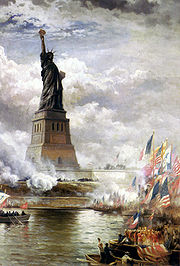
The Industrial Revolution played an important role in Gustave Eiffel's life. People were traveling across the world, new technologies and materials became available, and countries were industrializing. Much of Eiffel's work was affected by one or more of these conditions brought by the Industrial Revolution.
The condition that had the most impact on Eiffel's work was transportation. People around the world were demanding safe passages across rivers and were in need of bridges. Building these bridges is how Eiffel gained a reputation as an engineer, which allowed him to pursue larger and more difficult projects later in life. The bridges that he designed were constructed all over the world. The bridges allowed for easier and faster travel and trade in the geographical area in which they were constructed. Many of Eiffel's bridges did not require skilled workers for assembly, which made his bridges a great economical choice.
The Eiffel Tower had a huge impact on France. The tower was the focal point of the Exposition Universelle (1889) and drew millions of people to Paris. Nearly two million people visited the Eiffel Tower in 1889 alone. The tower quickly became a tourist attraction and brought large amounts of money into France's economy. After originally being thought of as an eyesore (it was actually designed to be torn down easily after the end of the Exposition), the tower quickly became a national symbol of France and brought a sense of pride to the people who live there. In 1910 Gustave Eiffel accomplished extraordinary outcomes in determining the wind resistance of a flat plate; Gustave used the Eiffel Tower as his test platform.
The Statue of Liberty was a gift from France to the United States. Eiffel's design for the interior structural elements of the statue allowed for the statue to become a reality. The statue showed the friendship and respect that was shared between France and the United States. The Statue of Liberty quickly became a national symbol of freedom in the United States and gave citizens a sense of pride. The statue became a great tourist attraction and brought many people to New York, boosting the economy. Several Americans living in France were pleased by the gift to their country and in turn, built a ¼ scale bronze model which stands on the downstream end of the Île des Cygnes, 1.4 km southwest of the Eiffel Tower.
With all the opportunities the Industrial Revolution brought with it, it also had many challenges. Just as Eiffel had the opportunity to work on more projects in different locations, so did other engineers. Competition for projects was extremely high and the reputation of the engineer played a major role for obtaining projects. Yet another challenge during Eiffel's career was the introduction of new construction materials. Since the new materials had not been proven in projects, engineers took a risk in using them. Many of the bridges Eiffel had built were made from steel which Eiffel had helped pioneer. With the thriving Industrial world of the time. Some of his advancements included: designing a system of hydraulic presses which allowed workers to set bridge foundations deep under water, creating sturdy yet lightweight "web-like" trusses and arches to withstand high winds, using wrought iron for bridge construction because its flexibility could withstand high winds, curving the edges of piers to create more stable bases, and the development of "launching" which is a way to more easily move pieces of structures into place. Eiffel's ingenuity and brilliance allowed him to design and build some of the world's most famous structures.
Buildings and structures
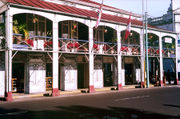
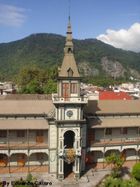
- Eiffel Tower
- Estación Central (main railway station), Santiago, Chile
- Budapest Nyugati Pályaudvar (Western railway station), Budapest, Hungary
- Konak Pier, Izmir, Turkey
- Nice Observatory
- Palacio de Hierro, Orizaba Veracruz, Mexico
- Paradis Latin, Paris
- San Sebastian Church, Manila, Philippines
- Statue of Liberty
- The General Post Office, Ho Chi Minh City, Vietnam
- The Market, Dijon, France
- Church of Santa Barbara, Santa Rosalia, Mexico
Bridges
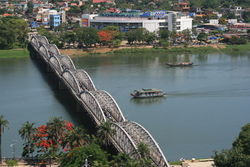
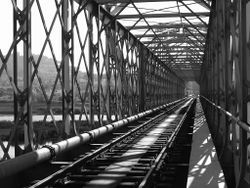
- Birsbrücke, Münchenstein, Switzerland which collapsed on 14 June in 1891 killing over 70 people. See Munchenstein rail disaster.
- Bridge over the Schelde in Temse, in Belgium
- Abu El-Ela Bridge in Cairo, Egypt
- Garabit Viaduct
- Garonne River Bridge near Bordeaux was Eiffel's first project at age 25.
- Long Bien bridge, Hanoi, Vietnam
- Maria Pia Bridge (Porto Viaduct)
- Railway Bridge near Constitución, Chile
- Souleuvre Viaduct
- The Eiffel Bridge in Viana do Castelo's Marina was a Gustav Eiffel's project from 1878.
- The Eiffel Bridge in Zrenjanin that was disassembled in the 1960s and is being rebuilt currently.
- The Railway Bridge over the Coura river in Caminha, Portugal.
- The road (D50) bridge over the River Lay at Lavaud in the Vendée, France
- Truong Tien Bridge is reflected in the Huong river, Hue, Viet Nam.
- Troitsky (Trinity) bridge in St. Petersburg, Russia
- Quezon Bridge in Quiapo District, Manila, Philippines
- Eiffel Bridge between Ungheni, Moldova and Romania
Other works
- Combier Distillery, Saumur (Loire Valley), France
- Viaduct over the Sioule river (1867)
- Viaduct at Neuvial (1867)
- Notre Dame des Champs, Paris (1868)
- Swing bridge at Dieppe (1870)
- Gasworks of La Paz, Bolivia
- La Paz Train Station, La Paz, Bolivia (now Bus Station of La Paz)
- Church at Tacna, Peru (1875)
- Church in Arica, Chile
- Ruhnu Lighthouse at Ruhnu island, Estonia (1877)
- Hotel Traian, at Iaşi, Romania (1884)

- Bolivar Bridge, at Arequipa, Peru
- Fenix Theatre, at Arequipa, Peru
- San Camilo Market, at Arequipa, Peru
- Church at Santa Rosalía, Baja California Sur, Mexico
- Bridge over the Tisza near Szeged, Hungary
- Farol de São Thomé in Campos, Brazil
- Theartwork of the Western Train station in Budapest, Hungary
- Great bridge over the Begej in Zrenjanin, Serbia, built in 1904, disassembled and replaced by concrete bridge in 1969
- Mona Island Lighthouse at Mona Island, Puerto Rico
- Plaza del Mercado (local produce market) at Mayagüez, Puerto Rico
- Bridge in Trujillo Alto (still there but not used anymore), Puerto Rico
- Puente Quezon (Quezon Bridge) over Pasig River, Manila, Philippines
- House of Steel in Maputo, Mozambique
- Ajfel Bridge On Skenderija Sarajevo, Bosnia and Herzegovina
- Dome (Salon Royale) of Hotel Negresco, Nice, France
- Pabellon de la Rosa Piriapolis, Uruguay
- Mercado Municipal, Manaus, Brazil
- Aérodynamique EIFFEL (wind tunnel), Paris (Auteuil), France
- La Cristalera, old portuary storage, El Puerto de Santa María, Spain
Not Proved
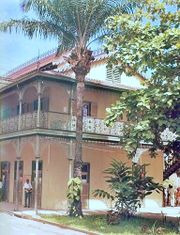
- (Bridge over the Cuyuni River, southern Venezuela)
- Santa Efigênia Viaduct, São Paulo, Brazil (1913)
- Santa Justa Lift (Carmo Lift), in Lisbon, Portugal (1901)
- Dam on Great Bačka Canal, Bečej, Vojvodina, Serbia (1900)
- Malleco Viaduct, Chile (1890)
- Palácio de Ferro, Angola (1890)
- The Chateau de Villersexel, Located in Villersexel France, (circa 1871)
Unrealized projects
- Trinity Bridge, Saint Petersburg—Eiffel entered a project into the contest, but his project was not realized.
References
- ↑ "Gustave Eiffel: The Man Behind the Masterpiece" Retrieved April 1, 2007.
- ↑ Mona Island Lighthouse, from Lighthouse Digest. Retrieved April 17, 2006.
- ↑ Gustave Eiffel, from the official site of the Eiffel Tower. Retrieved April 17, 2006.